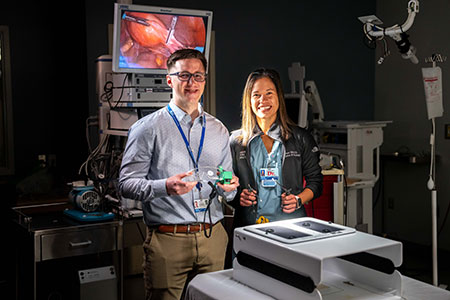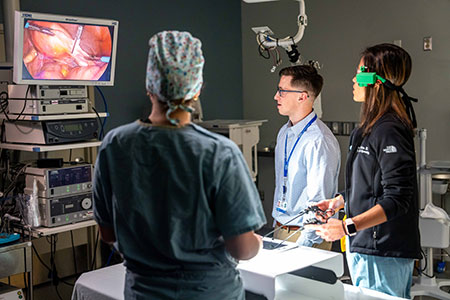Physician and MSU doctoral students launch LaparAssist, Inc. to improve communication in the OR
 Minimally invasive gynecologic surgeon Annmarie Vilkins, DO, envisioned a better way to communicate with and teach student doctors when her hands were literally full during laparoscopic procedures.
Minimally invasive gynecologic surgeon Annmarie Vilkins, DO, envisioned a better way to communicate with and teach student doctors when her hands were literally full during laparoscopic procedures.
“Physicians always have good ideas but no time to do anything with them,” Dr. Vilkins said.
Enter a group of Michigan State University biomedical engineering doctoral students and Henry Ford Innovations.
In an example of the value of the Henry Ford Health + MSU Heath Sciences partnership, the students were shadowing clinicians at Henry Ford Hospital and one aspect of the class was to design a device that could improve clinical practice.
“It was really symbiotic that I had these brilliant students to hand my idea to and say, ‘let’s try this,’” Dr. Vilkins said.
Henry Ford Innovations engages with corporations, universities, incubators and accelerators to identify products and services to further develop, test and/or implement at Henry Ford Health and beyond. It was instrumental in connecting Dr. Vilkins with the students and supporting them all along the way.
LaparAssist Inc. was founded by Dr. Vilkins and four students, including CEO Colin O’Hern; Chief Financial Officer Simon Sanchez; Chief Operating and Technical Officer Kay Hadrick and Max Hakun, Vice President of Engineering and Prototyping. Dr. Vilkins serves as Chief Medical Officer. Innovations helped secure a patent for the invention and entered into a licensing agreement with the newly created LaparAssist Inc. in December 2023.
How LaparAssist works
 During a laparoscopic procedure, communication is key, particularly at any medical training institution. This becomes challenging when the attending surgeon has both hands occupied with laparoscopic instruments and then must rely on verbal communication only. Dr. Vilkins’ concept was to somehow use a laser pointer mounted to headgear. She could then use her head and as extra hand to show the trainee exactly where to go by pointing on the monitor they use to see inside the patient. While many safety measures and practices are in place already, this would add another layer of safety by enhancing communication.
During a laparoscopic procedure, communication is key, particularly at any medical training institution. This becomes challenging when the attending surgeon has both hands occupied with laparoscopic instruments and then must rely on verbal communication only. Dr. Vilkins’ concept was to somehow use a laser pointer mounted to headgear. She could then use her head and as extra hand to show the trainee exactly where to go by pointing on the monitor they use to see inside the patient. While many safety measures and practices are in place already, this would add another layer of safety by enhancing communication.
“It’s a communication aid to help trainees grow. The surgeon is always in complete control. This only enhances safety – it allows me to double and triple check the trainee before they do anything. We are always looking for ways to enhance surgical education,” says Dr. Vilkins.
The laser pointer on the headgear uses Bluetooth technology and is activated by a pedal on the floor. All the surgeon needs to do is press the pedal and point the laser to the spot on the monitor.
“We used the technical engineering skills we have to build out her idea to fit her needs,” said O’Hern, a MSU College of Osteopathic Medicine DO/PhD candidate and medical student, who plans to become a physician-scientist. “The fact that we knew we had support from Henry Ford Health and Innovations should we choose to commercialize our invention was a real incentive for us to put our best foot forward.”
What’s next?
Innovations helping the team incorporate and file a utility patent. Now O’Hern, Dr. Vilkins and the team are optimizing their prototype device with the goal of eventually making it available for purchase to both individual physicians and healthcare facilities.
.svg?iar=0&hash=F6049510E33E4E6D8196C26CCC0A64A4)
/hfh-logo-main--white.svg?iar=0&hash=ED491CBFADFB7670FAE94559C98D7798)